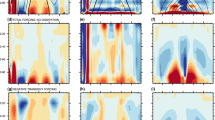Summary
Circulation patterns were obtained from a two-level quasi-geostrophic model, in which the Rossby parameter varied with latitude. The initial basic state was characterized by a constant zonal flow at both reference level. The results we re compared with the pattern obtained in a series of experiments with a similar model, in which the Rossby parameter was assumed to be constant. the initial zonal flow in these experiments was assumed in one case to be constant with latitude, in the second casse to have a symmetrical jet centered on the central latitude, and in the thrid case to have its maximum in the southern half of the region. the results of the experiment with a variable Rossby parameter have the closest resemblance to the patterns observed in the real atmospehre. In particular, during the mature stages of the run, the distribution of the zonallyaveraged eddytransport of momentum corresponded quite well to patterns actually observed in the atmosphere.
Zusammenfassung
Aus einem quasi-geostrophischen Modell mit breitenabhängigem rossby-Parameter wurden Zirkulationsformen errechnet. Der Anfangszustand war durc eine konstante zonale Strömung in zwei Niveaus charakteriseirt. Die Resultate wurden mit Zirkulationen verglichen, die in einer Reihe von Experimenten mit einem ähnlichen Modell, in dem aber der Rossby-Parameter konstant angenommen war, erhalten worden waren. In einemk dieser Fälle wurde angenommen, daß die ursprüngliche zonale Strömung breitenunabhängig war, in einem anderen fall wurde angenommen, daß die Strömung in einem symmetrischen Jetstream über eine mittleren Breite konzentriert war, und in einem dritten Fall wurden angenommen, daß die zonale Strömung ihr Maximum in der südlichen Hälfte des Bereiches hatte. Die Resultate des Experiments mit dem veränderlichen Rossby-Parameter haben die meiste Ähnlichkeit mit Zirkulationsformen in der wirklichen Atmosphäre. Insbesondere paßt die Verteilung des zonal gemittelten Momentumtransports in den Reifestadien des Versuchs gut zu den tatsächlich in der Atmosphäre beobachteten Zirkulationsformen.
Résumé
On a calculé les formes de circulation découlant d'un modèle quasigéostrophique dont le paramètres de Rossby dépendaient de la latitude. L'état initial en était caractérisé par un courant zonal constant aux deux niveaux. Lels résultats ont été comparés à ceux d'une série d'essais effectués avec un modèle semblable, mais dans lequel les paramètres de Rossby restaient constants. Dans un de ces cas, on a admis que la circulation zonale initiale ne dépendait pas de la latitude. Dans un deuxième, on a simulé un “jet” symétriquement à une latitude moyenne. Dans un troisième enfin, on a placè le maximum de la circulation zonale dans la moitié sud de l'espace étudié. Les résultats obtenus en partant des essais basés sur un paramètre de Rossby variable sont les plus semblables aux formes de circulation observées réellement dans l'atmosphère. En particulier, la répartition du transport turbulent de la quantité de mouvement — moyenne zonale calculée au stade de maturité de l'essai — est très voisine des formes de circulation observées réellement dans l'atmosphère.
Similar content being viewed by others
References
Arakawa, A.: Nongeostrophic effects in the Baroclinic Prognostic Equations. Proc. Internat. Symposium in Numerical Weather Prediction in Tokyo, Nov. 7–13, 1960, 161–175 (1962).
Huss, A., andY. Mintz: Growth of a Baroclinic Wave and Evolution of the Mean Zonal and Mean Meridional Circulations. Proc. Internat. Symposium in Numerical Weather Prediction in Tokyo, Nov. 7–13, 1960, 530–553 (1962).
Huss, A.: The Developing Circulation Patterns on a β-plane Obtained in the Case of an Intiial Basic Flow Varying Sinusoidally with Latitude. Arch. Met. Geoph. Biokl., Ser. A,15, 265–279 (1966).
Huss, A.: Numerical Integration of a Two-level Quasi-geostrophic Model of the Atmosphere with an Initial State Characterized by an Asymmetric Zonal Current. Pageoph64, 156–168 (1966).
Lipps, F. B.: Momentum Transfer across an Asymmetric Jet. Technical Report No. 17to the National Science Foundation, August 1964. University of Chicago, Dept. of Geophysical Sciences (1964).
Mintz, Y.: The Observed Zonal Circulation of the Atmosphere. Bull. Amer. Met. Soc.35, 208–214 (1954).
Mintz, Y.:. Design of Some Numerical General Circulation Experiments. Bull. Res. Council Israe: Geo-Sciences7, G, 67–114 (1958).
Ogura, Y.: Wave Solutions of the Vorticity Equation for the 21/2 Dimensional Model. J. Meteor.14, 60–64 (1957).
Pisharoty, P. R.: The Kinetic Energy of the Atmosphere, Article XIV, in: Final Report, Contract AF 19(122)-48, Dept. of Meteorology, U. C. L. A. (1955).
Staff Members of Electronic Computation Center, Japan Meteorological Agency: Baroclinic Forecast by Diabatic Quasi-Geostrophic Model. Journ. Meteor.Soc. of Japan43, 246–261 (1965).
Wiin-Nielsen, A.: On Certain Integral Constraints for the Time-Integration of Baroclinic Models. Tellus11, 45–59 (1959).
Wiin-Nielsen, A., J. A. Brown, andM. Drake: On Atmospheric Energy Conversions between the Zonal Flow and the Eddies. Tellus15, 261–279 (1963).
Author information
Authors and Affiliations
Additional information
With 9 Figures
The research reported in this document has been sponsored by the Air Force Cambridge Research Laboratories under Grant AF EOAR 63-108 through the European Office of Aerospace Reasearch (OAR), United States Air Force.
Rights and permissions
About this article
Cite this article
Huss, A. A numerical integration of a two-level quasi-geostrophic model with variable Rossby parameter. Arch. Met. Geoph. Biokl. A. 16, 105–125 (1967). https://doi.org/10.1007/BF02246393
Received:
Issue Date:
DOI: https://doi.org/10.1007/BF02246393




